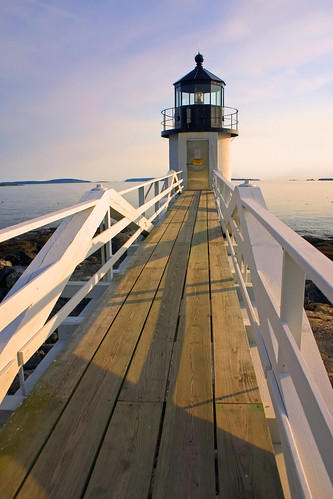
Eleven-acre Bear Island, near the town of Northeast Harbor on Mount Desert Island, is one of the island group known as the Cranberry Isles. Nineteenth-century landscape artists, including Frederick Church and Albert Bierstadt, were drawn to Bear Island’s rugged beauty. The historian Charles B. McLane postulated that the island’s name was originally “Bare.” McLane believed that the name stemmed from the island’s treeless appearance from the west rather than the unlikely presence of bears.
Congress appropriated $3,000 for the building of a lighthouse on the island in July 1838, and the station went into service in 1839. The first lighthouse building took the form of a wooden tower on the southern end of the roof of a small rubblestone dwelling. John G. Bowen (sometimes spelled “Bowan”) was the first keeper.
Lighthouse-keeping appointments were highly political in the first half of the nineteenth century. After Bowen was dismissed in 1842, Secretary of the Treasury Walter Forward explained the reasons. “Interference in elections, both under the late and present administrations, and absence from the lighthouse for days in succession are the principal charges against Mr. Bowen,” Forward wrote to a Maine congressman in June 1842.
John Bowen returned for a second stint as keeper (1844–50). In March 1850, a local politician, Charles Peters, wrote to a justice of the peace in favor of Bowen’s removal: “Washington needs to know what kind of a critter Bowan has been. . . . if he has been known to attend political conventions . . . if he has been an active and brawling Partizan. . . . I want to sluice Bowan before he knows it.” After many prominent Whigs signed a petition, Bowen was removed in favor of Levi Robinson, a native of the nearby town of Tremont.
A fire did great damage to the lighthouse building in 1852, and the 1854 annual report of the lighthouse board announced that the station had been rebuilt. The new lighthouse consisted of a round brick tower at one end of the dwelling.
Around the time of the station’s rebuilding, John G. Bowen returned for a third and final stint as keeper (1853–55). Caleb S. Gould succeeded Bowen in 1855. It isn’t clear how many children Gould had, but there were enough, in combination with one other family on the island, for Bear Island to be named a separate school district under Gould’s direction in 1856.
A fifth-order Fresnel lens was installed in 1856. In 1888, a 1,000-pound fog bell and striking apparatus were installed. The present 31-foot brick lighthouse was built in 1889–90 after a congressional appropriation of $3,750, as were a new one-and-one-half-story, wood-frame keeper’s house and a barn.
Elmo J. Turner was the keeper for some years in the 1930s, after time at Great Duck Island Light. Like many lighthouse families, Turner and his wife kept chickens and a cow at the island station.
“There was no power on the island,” says Turner’s great-granddaughter, Joyce MacIlroy, “so my great-grandmother would keep the fresh cream in the cellar.
"One day, the cow had to be taken to the mainland, so Elmo loaded her into the dory and rowed her across to Northeast Harbor, then rowed her back over to the island. The cow got seasick on the way back—that must have been quite the sight!”
In the early 1980s, Bear Island Light was discontinued and replaced by an offshore lighted bell buoy. The property became part of Acadia National Park in 1987. Through most of the 1980s, the station fell into disrepair.
In 1989, the Friends of Acadia refurbished the keeper's house for $17,000 and the tower was relighted as a private aid to navigation. The National Park Service then granted a long-term lease on the property to Martin Morad, who is required to pay for the upkeep of the property.
Morad, originally from Iran, is a professor of pharmacology and medicine at Georgetown University. Fabiola Martens, his wife, is Belgian. She is a former lawyer and now is an interior designer. Morad had originally seen Bear Island Lighthouse in 1971 and had attempted to buy or lease it to no avail. By 1989, the house had fallen into such poor condition that it took three years of renovation before Morad and Martens could move in.
Click here for much more information on this lighthouse.


